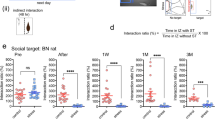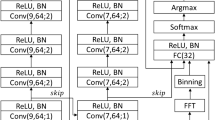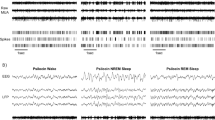Abstract
Antidepressants belonging to the class of monoamine oxidase inhibitors (MAOI) such as phenelzine have long been known to drastically suppress REM sleep. Sleep and the electroencephalogram (EEG) in sleep and waking were studied in three depressed patients at regular time intervals before, during and after 6 to 18 months of phenelzine treatment. While REM sleep was initially eliminated in all patients, short REM sleep episodes reappeared after three to six months of medication. Total sleep time and EEG slow-wave activity (SWA, spectral power within 0.75–4.5 Hz) in nonREM sleep (stages 1–4) were not changed. In contrast, EEG theta frequency activity (TFA, power within 4.75–8.0 Hz) during a 5-min wake interval recorded prior to the sleep episodes was initially enhanced, and tended to correlate negatively with the percentage of REM sleep (p = .06). This observation indicates that compensatory REM sleep mechanisms may occur in wakefulness during chronic MAOI treatment.
Similar content being viewed by others
Log in or create a free account to read this content
Gain free access to this article, as well as selected content from this journal and more on nature.com
or
References
Akindele MO, Evans JI, Oswald I . (1970): Mono-amine oxidase inhibitors, sleep and mood. Electroenceph clin Neurophysiol 29: 47–56
Dement W . (1960): The effects of dream deprivation. Science 131: 1705–1707
Dunleavy DLF, Oswald I . (1973): Phenelzine, mood response, and sleep. Arch Gen Psychiatry 28: 353–356
Endo T, Roth C, Landolt HP, Werth E, Aeschbach D, Achermann P, Borbély AA . (1998): Selective REM sleep deprivation in humans: effects on sleep and sleep EEG. Am J Physiol 274: R1186–R1194
Horne JA . (2000): REM sleep-by default? Neurosci Biobehav Rev 24: 777–797
Landolt HP, Raimo EB, Schnierow BJ, Kelsoe JR, Rapaport MH, Gillin JC . (2001): Sleep and sleep electroencephalogram in depressed patients treated with phenelzine. Arch Gen Psychiatry 58: 268–276
Rechtschaffen A, Kales A . (eds) (1968): A manual of standardized terminology, techniques and scoring system for sleep stages of human sleep. Washington, D.C.: Public Health Service, U.S. Government Printing Office
Wyatt RJ, Fram DH, Buchbinder R, Snyder F . (1971a): Treatment of intractable narcolepsy with a monoamine oxidase inhibitor. New Engl J Med 285: 987–991
Wyatt RJ, Fram DH, Kupfer DJ, Snyder F . (1971b): Total prolonged drug-induced REM sleep suppression in anxious-depressed patients. Arch Gen Psychiatry 24: 145–155
Acknowledgements
We wish to dedicate this manuscript to Dr. J. Christian Gillin and thank him cordially for his generous support. We thank R. Wong, A. Schlosser and D. Sweat for their help with data collection, Drs. E. Raimo and B. Schnierow for clinical care, Dr. A. A. Borbély for lending us two PS-1 recording systems, and Drs. P. Achermann, C. Kopp and I. Tobler for comments on the manuscript. The study was supported by the Swiss National Science Foundation (823A-0566161), the National Institute of Mental Health (MH38738), the UCSD MHCRC (MH30914), the General Clinical Research Center (M01-RR00827), the Department of Veterans Affairs, and the UCSD Fellowship in Psychopharmacology and Psychobiology.
Author information
Authors and Affiliations
Corresponding author
Rights and permissions
About this article
Cite this article
Landolt, HP., de Boer, L. Effect of Chronic Phenelzine Treatment on REM Sleep: Report of Three Patients. Neuropsychopharmacol 25 (Suppl 1), S63–S67 (2001). https://doi.org/10.1016/S0893-133X(01)00321-9
Issue date:
DOI: https://doi.org/10.1016/S0893-133X(01)00321-9
Keywords
This article is cited by
-
Antidepressants and Their Impact on Sleep
Current Sleep Medicine Reports (2020)
-
Differential adaptation of REM sleep latency, intermediate stage and theta power effects of escitalopram after chronic treatment
Journal of Neural Transmission (2013)



